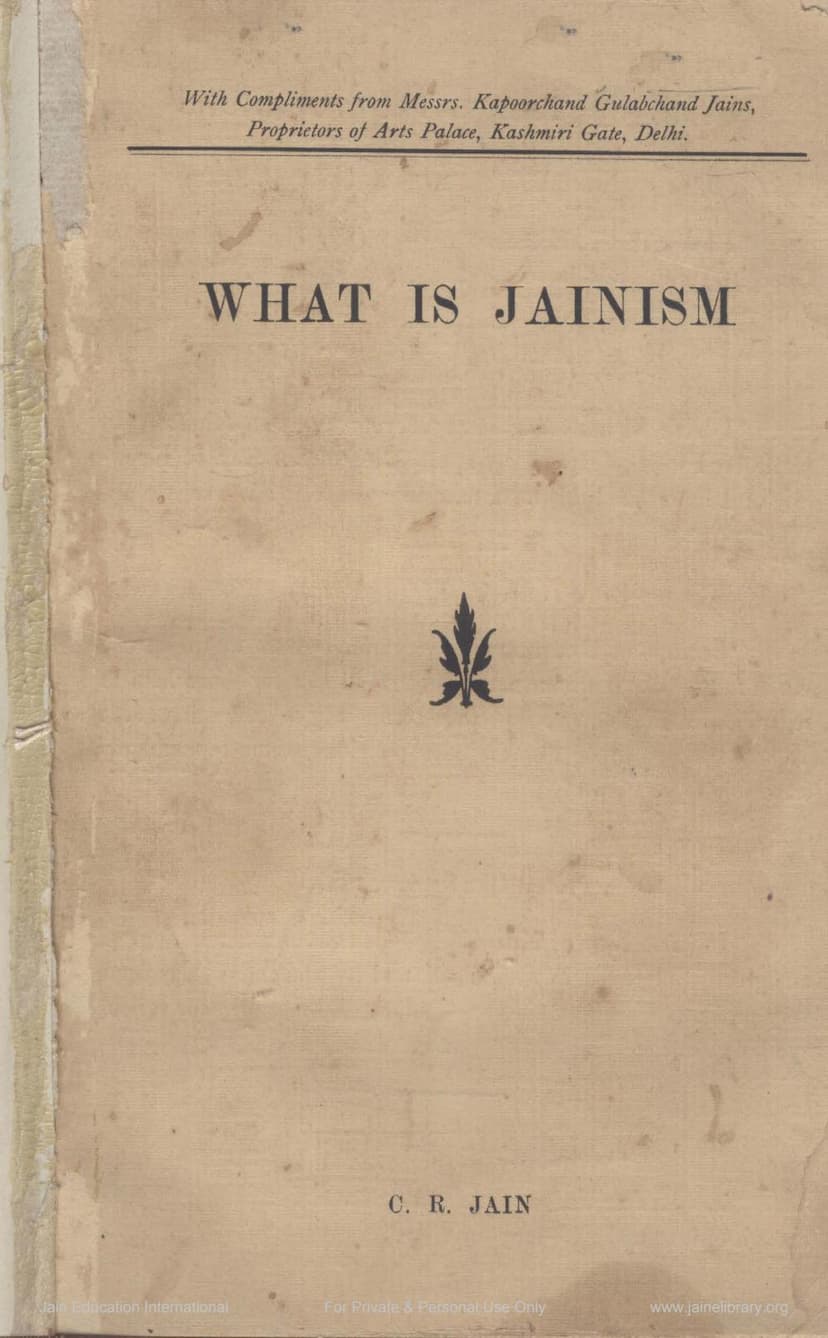What Is Jainism
Added to library: September 2, 2025
Loading image...

Summary
This document is a collection of essays and addresses by C. R. Jain, offering a comprehensive exposition of Jainism. The author presents Jainism not as a set of arbitrary rules but as a science aimed at liberation from suffering through the realization of the soul's inherent perfection.
Key Themes and Concepts:
- Jainism as a Science: The text repeatedly emphasizes that Jainism is a science, not a religion based on dogma or superstition. It is founded on reason and the knowledge of perfected souls (Tirthamkaras).
- The Nature of the Soul (Jiva): The soul is described as an eternal, simple, and pure conscious substance, inherently omniscient, blissful, and powerful. Its natural state is perfection, but this is obscured by ignorance and the influence of matter.
- The Goal of Religion: The ultimate aim of religion, according to Jainism, is liberation (moksha) from the cycle of birth and death (samsara) and the attainment of the soul's innate divine qualities: omniscience, immortality, and bliss.
- The Seven Tattvas: The foundational principles of Jainism are explained through seven essential categories:
- Jiva (Soul): The conscious, living substance.
- Ajiva (Non-soul): Non-living substances, including matter (pudgala), space, time, and motion/rest principles.
- Asrava (Influx): The inflow of karmic matter into the soul due to passions and activities.
- Bandha (Bondage): The state of the soul being bound by karmic matter, which obscures its natural qualities.
- Samvara (Checking): The process of stopping the influx of new karmic matter.
- Nirjara (Elimination): The process of shedding or destroying existing karmic matter.
- Moksha (Liberation): The state of ultimate freedom, omniscience, and bliss, achieved when the soul is freed from all karmic bondage.
- Karma: Actions (physical, mental, or vocal) create karmic matter that attaches to the soul, leading to bondage. The nature of one's actions determines the type of body and experiences in future lives.
- Right Belief, Right Knowledge, Right Conduct: The path to liberation is through the triad of Right Belief (Samyak Darshan), Right Knowledge (Samyak Gyana), and Right Conduct (Samyak Charitra).
- Ahimsa (Non-violence): Ahimsa is presented as the highest religion (Ahimsa Paramo Dharma). It is not merely the absence of physical harm but a principle that extends to thought, word, and deed, encompassing compassion and respect for all life.
- Ideal of Perfection: The Tirthamkaras are presented as the highest exemplars of perfected souls who have achieved liberation. Jainism advocates "idealatry" (devotion to ideals) rather than idolatry, with the images in temples serving as reminders and inspirations for the devotee to follow their path.
- Rejection of Creationism: Jainism posits an eternal universe without a creator God. The world-process is explained through the interaction of eternal substances and natural laws.
- Syadvada (Conditional Predication): This philosophical doctrine addresses the complexities of reality by asserting that all statements are conditional and made from a particular viewpoint. It acknowledges that things can be described from multiple perspectives, leading to seemingly contradictory statements that are, in fact, reconcilable when understood correctly.
- Psychology with a Soul: The author delves into psychology, arguing for the existence of a simple, immortal, conscious soul distinct from matter. He refutes materialistic explanations of consciousness and emphasizes the soul's inherent nature as pure intelligence and bliss.
- Comparative Religion: Jainism is presented as a universal science of life that shares fundamental truths with other rational religions, often obscured by allegory and misunderstanding. The author suggests that a proper scientific interpretation of religious scriptures can reveal this underlying unity.
- Role of Asceticism and Renunciation: The importance of self-discipline, renunciation of desires, and ascetic practices is highlighted as the means to purify the soul and overcome the bondage of matter.
- Critique of Modern Civilization: The author contrasts ancient Indian civilization, which prioritized spiritual development, with modern civilization, which he sees as materialistic, costly, and detrimental to spiritual growth.
- Social Reform: The essays touch upon the importance of women's education, ethical conduct, and the need for individual self-improvement as the basis for societal reform.
In essence, C. R. Jain's work aims to present Jainism as a logical, scientific, and practical path to spiritual liberation and ultimate well-being, emphasizing the inherent divinity of the soul and the power of self-effort through right knowledge, belief, and conduct.